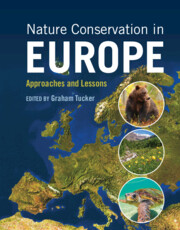Book contents
- Nature Conservation in Europe
- Nature Conservation in Europe
- Copyright page
- Dedication
- Contents
- Contributors
- Preface
- Acknowledgements
- Glossary, Abbreviations and Country Codes
- Chapter 1 Introduction: Aims, Scope, Structure and Key Information Sources
- Chapter 2 Europe’s Nature and Conservation Needs
- Chapter 3 The International Drivers of Nature Conservation, Their Objectives and Impacts on Nature Conservation Policies and Actions in Europe
- Chapter 4 Nature Conservation Policy, Legislation and Funding in the EU
- Chapter 5 Conclusions, Lessons Learnt and Implications for the Future
- Chapter 6 Austria
- Chapter 7 Belgium
- Chapter 8 Republic of Bulgaria
- Chapter 9 Republic of Croatia
- Chapter 10 Cyprus
- Chapter 11 The Czech Republic
- Chapter 12 Denmark
- Chapter 13 Estonia
- Chapter 14 Finland
- Chapter 15 France
- Chapter 16 Germany
- Chapter 17 Greece
- Chapter 18 Hungary
- Chapter 19 Ireland
- Chapter 20 Italy
- Chapter 21 Latvia
- Chapter 22 Lithuania
- Chapter 23 The Netherlands
- Chapter 24 Poland
- Chapter 25 Portugal
- Chapter 26 Romania
- Chapter 27 Slovakia
- Chapter 28 Slovenia
- Chapter 29 Spain
- Chapter 30 Sweden
- Chapter 31 United Kingdom
- Appendix Habitats Directive Annex I Habitat Types Referred to in This Book
- Index
- References
Chapter 1 - Introduction: Aims, Scope, Structure and Key Information Sources
Published online by Cambridge University Press: 11 May 2023
- Nature Conservation in Europe
- Nature Conservation in Europe
- Copyright page
- Dedication
- Contents
- Contributors
- Preface
- Acknowledgements
- Glossary, Abbreviations and Country Codes
- Chapter 1 Introduction: Aims, Scope, Structure and Key Information Sources
- Chapter 2 Europe’s Nature and Conservation Needs
- Chapter 3 The International Drivers of Nature Conservation, Their Objectives and Impacts on Nature Conservation Policies and Actions in Europe
- Chapter 4 Nature Conservation Policy, Legislation and Funding in the EU
- Chapter 5 Conclusions, Lessons Learnt and Implications for the Future
- Chapter 6 Austria
- Chapter 7 Belgium
- Chapter 8 Republic of Bulgaria
- Chapter 9 Republic of Croatia
- Chapter 10 Cyprus
- Chapter 11 The Czech Republic
- Chapter 12 Denmark
- Chapter 13 Estonia
- Chapter 14 Finland
- Chapter 15 France
- Chapter 16 Germany
- Chapter 17 Greece
- Chapter 18 Hungary
- Chapter 19 Ireland
- Chapter 20 Italy
- Chapter 21 Latvia
- Chapter 22 Lithuania
- Chapter 23 The Netherlands
- Chapter 24 Poland
- Chapter 25 Portugal
- Chapter 26 Romania
- Chapter 27 Slovakia
- Chapter 28 Slovenia
- Chapter 29 Spain
- Chapter 30 Sweden
- Chapter 31 United Kingdom
- Appendix Habitats Directive Annex I Habitat Types Referred to in This Book
- Index
- References
Summary
The chapter provides an overview of the aims and scope of the book (including the European countries covered), its structure and standard topics covered in each country. Includes the general objectives of the Birds and Habitats Directives, and the standard categories used to report on the status of habitats and species. Protected areas and their categories are defined. Key data sources are identified, including for the status of habitats and species; protected area coverage; and nature conservation costs and funding. The taxonomy and sources of species names are listed.
Keywords
- Type
- Chapter
- Information
- Nature Conservation in EuropeApproaches and Lessons, pp. 1 - 12Publisher: Cambridge University PressPrint publication year: 2023



